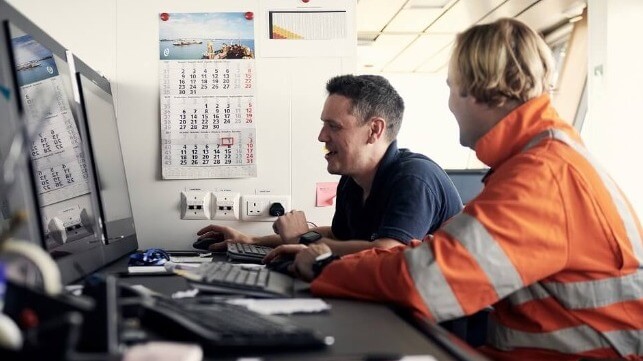Powering the People That Power World Trade

 We are going through an era of seismic change in our industry. We are thankfully emerging from the global pandemic, but crewing remains pressured by ongoing Covid disruption and the new challenges of the conflict in Ukraine. Both have taken their toll on our seafarers and those that support and rely on them ashore.
We are going through an era of seismic change in our industry. We are thankfully emerging from the global pandemic, but crewing remains pressured by ongoing Covid disruption and the new challenges of the conflict in Ukraine. Both have taken their toll on our seafarers and those that support and rely on them ashore.
Digitization continues apace in our industry, gaining momentum in the pandemic. It brings many benefits, minimizing human error, automating laborious processes and helping us to understand what is really going on in our organizations. However, it also brings new challenges for cyber security, greater digital literacy and development of new skills.
Technology and new fuels are also in sharp focus as key to delivering our decarbonization targets. The world’s ambitions for carbon reduction by 2050, and the 2030 targets that they rely on, simply cannot happen without a huge effort from the shipping community. Whilst more clarity is needed on the fuels of the future, we can already predict the need for a huge effort in maritime skills training.
Whatever fuels we use, there will be a focus on energy efficiency and environmental sustainability. This, coupled with the welcome attention to seafarer welfare we have seen in the last few years, is part of an increased interest in the ethical dimension of business.
ESG provides a means to assess performance in this regard, combining environmental sustainability with social factors, such as providing safe healthy and secure working environments for our workers, raising of our levels of governance and encouraging sustainable decision making through transparency and accountability.
These are becoming increasingly core to decisions on investment and consequently the viability of businesses.
So, what will all these dimensions mean for our maritime professionals? How will the drive to more sustainable shipping and emissions targets and the new fuels and emergent and technologies we will need as well as a broader move to digitization impact the work that they do and the skills that they need? And how will we find, attract and retain the talent that will be required in the uncertain world emerging from the global pandemic when we already see a shortage of quality mariners on the horizon?
Luckily there are many tools available to us in the here and now that can help our maritime professionals to meet these challenges.
Finding and retaining the people we need
The world needs skilled and competent seafarers. The recent ICS BIMCO Seafarer Workforce Report predicts a shortage of 26,000 STCW certified officers ahead. In addition, anxiety is building as to what effect reports of the crew change crisis will have on the people considering a career at sea. We also do not yet know how many of the seafarers that have endured this hardship will consider whether it is time to find a new career.
With the challenges we face today and our aspirations for tomorrow, we cannot afford a drain on talent. Having the right people on your team will be the differentiator, and recruitment and retention of quality candidates will be more important than ever.
The reality is that we are also having to look at new and less familiar crew pools to meet demand and keep sailing.
Recruiters need pre-employment assessment tools such as ours, which can provide an accurate and objective picture of a seafarers’ knowledge, ability and personality profile. The best tools also evaluate English language proficiency, which is vital for onboard communication.
Simulation has long been a valued addition to pre-assessing candidates. Cloud-based simulation provides us the ability to conduct crew assessments at scale and the pay-per-use model makes it deliverable at a cost-effective price point.
But it’s not just about what candidates can offer us. We will need to be just as focused on what we can offer them. The skilled personnel we will need for the future are also wanted on shore, and we will be competing with industries that can offer attractive packages and quality of life.
Good pay and benefits will always be the main driver, but increasingly, statistics show that people are making judgements on the nature of the company that will employ them. This includes their culture and values and whether they do what they say they do.
Creating a great employee experience
“Culture eats strategy for breakfast,” as the saying goes, and it is a growing feature in Industry guidelines and reports. A strong culture underpinned by meaningful values is not only attractive to candidates, it also enables decision making and ensures that people do the right thing much more effectively than they might under a set of enforced rules.
Onboarding people into the organization and familiarizing them becomes vitally important. Reaching into the organization to get feedback and checking that your initiatives are working - as well as campaigning on issues specific to your fleet - is essential.
For this reason, we have designed our learning platform and developed tooling that makes it possible for our customers to communicate their values, both onboard and for the familiarization of new joiners. By using our Rapid E-learning authoring tool and our integrated Pulse Surveys to gather feedback, our customers can evaluate how their people are responding to their initiatives, whether at sea or ashore. These tools - along with our library of titles covering welfare, diversity, leadership, bullying and harassment, among other issues - can help to provide resources and demonstrate commitment to a good workplace culture.
A good company culture also means providing your teams with the tools they need to make their jobs manageable. Software is undoubtedly going to play a massive part in managing these demands, and we need to enable our maritime professionals to succeed, minimizing workload and reducing inefficiencies.
Help with the heavy lifting
If we take the example of crew change, perhaps the biggest challenge we have faced in the last two years, we can see how software can help.
Ensuring that crew have the right documentation, certificates and endorsements, the right amount of sea-time, medical, insurance and employment agreements in place, arranging travel, visas – all these steps require communication with multiple stakeholders and are prone to human error. Software is simply much better at managing this than we are, and in a well-designed platform such as our Compas Crew Management System, it can all be managed through smart workflows, reducing many of these operations to a single click.
Moreover, Compas Crew Management can help to forecast your options for crew change next week, next month and even years into the future, allowing you to identify staffing needs and succession plans.
Saving time
Most maritime professionals in the office and at sea are not short on ideas, but they are all short on time. The time spent on admin duties could be spent on the things that really matter. In the interest of time, I will simply list a few examples:
E-learning, AI Proctoring, cloud simulation and virtual classroom all allow more and more training to be done remotely saving precious time away from home for our seafarers.
Micro learning and adaptive learning combine to deliver more relevant learning that minimize learner seat time, both onshore and at sea.
Automated data-exchange and advances in digital delivery lessen the admin burden on board and also shorten the time to distribute urgent material to the fleet.
Apps like our TM Master Purchasing app allow users to review orders from any connected device ensuring that supply chains are not hindered by POs stacking up in the pipeline awaiting approval.
Saving Costs
With rising costs across the board, it is important that the technology solutions we deliver also deliver savings of their own.
One obvious example is in the savings achieved by e-learning delivery. When factoring in travel, hotels and sustenance, some estimate the savings at as much as 80 percent over an attendance course.
Marketplace scanning features such as the Integrated Travel module in our Compas software simplify corporate travel with API integrations to multiple travel agents, allowing you to compare multiple providers and the use of historic information for real time cost analysis.
And our Fleet Management solution TM Master enables you to reduce the time auditors need to be on board by having the data they need readily accessible in the format required.
Tools to understand your information
Data is becoming more and more central to all our operations. There is clear value in being able to combine data sets and analyze trends. We have more data points available than ever before. In 2019, it was estimated that the maritime industry as a whole was generating 100 to 120 million data points every day.
But if data lacks quality or is siloed, or the company lacks the data science expertise to work with it effectively, it becomes more of a headache than a help. We find ourselves with too much data and not enough insight.
It is therefore essential that we leverage skills in UX and data visualization to provide easy to read dashboards and reports that can be used to enable decision making and prove excellence.
Tools to prove it
The demands of regulatory compliance, Industry conformance standards such as TMSA and additional charterer requirements all require evidence that standards are being met. With the addition of ESG, the bar is raised substantially on what needs to be recorded and reported.
Transparency and the ability to demonstrate your commitment to its principles will be a competitive differentiator. Setting a strategy in place for improving your sustainability in which you can capture a vast range of data points and understand what they are telling you cannot be done without good content and a proven software solution.
While we face an unprecedented period of change that will undoubtedly bring challenges, there are also great opportunities for those companies that can quickly reorient to new ways of working and are able to understand and report their data.
The demand for greater transparency and the need to attract talent will drive us to be more thoughtful and creative in the way we think about the employee experience and how we enable our teams to succeed. Getting the most from the tools at our disposal will help us to power the people that power world trade.
Raal Harris is Group Creative Director at Ocean Technologies Group.
This article is sponsored by OTG. For more information, please visit https://www.oceantg.com/.
The opinions expressed herein are the author's and not necessarily those of The Maritime Executive.
